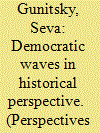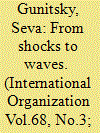| Srl | Item |
| 1 |
ID:
161321


|
|
|
| 2 |
ID:
161309


|
|
|
|
|
| Summary/Abstract |
For over two centuries, the evolution of democracy has been marked by repeated democratic waves. Yet these cross-border bursts of revolution and reform have varied widely in their origins, intensity, and success rates. How do we compare cascades of regime change, and what lessons do they offer about the spread of democracy? I lay out a historical framework of democratic waves that focuses on recurring causal mechanisms across time. Thirteen democratic waves are categorized according to two dimensions: 1) the origins of external influence, located in either vertical hegemonic transformations or in horizontal cross-border linkages; 2) the strength of external influence, taking the form of contagion when outside forces dominate and emulation when domestic focal points shape the timing of contention. This approach allows for more meaningful comparisons between these important, recurring, yet seemingly incomparable democratic waves. More generally, it suggests that the global history of democracy cannot be reduced to the sum of its national trajectories.
|
|
|
|
|
|
|
|
|
|
|
|
|
|
|
|
| 3 |
ID:
133274


|
|
|
|
|
| Publication |
2014.
|
| Summary/Abstract |
What causes democratic waves? This article puts forward a theory of institutional waves that focuses on the effects of systemic transformations. It argues that abrupt shifts in the distribution of power among leading states create unique and powerful incentives for sweeping domestic reforms. A variety of statistical tests reveals strong support for the idea that shifts in hegemonic power have shaped waves of democracy, fascism, and communism in the twentieth century, independent of domestic factors or horizontal diffusion. These "hegemonic shocks" produce windows of opportunity for external regime imposition, enable rising powers to rapidly expand networks of trade and patronage, and inspire imitators by credibly revealing hidden information about relative regime effectiveness to foreign audiences. I outline these mechanisms of coercion, influence, and emulation that connect shocks to waves, empirically test their relationship, and illustrate the theory with two case studies-the wave of democratic transitions after World War I, and the fascist wave of the late interwar period. In sum, democracy in the twentieth century cannot be fully understood without examining the effects of hegemonic shocks
|
|
|
|
|
|
|
|
|
|
|
|
|
|
|
|
| 4 |
ID:
168558


|
|
|
|
|
| Summary/Abstract |
“Parsimony” is a vague and divisive concept in political science. I identify three distinct but often conflated conceptions of parsimony. The aesthetic conception emphasizes a theory's elegance and clarity; the ontological conception, drawing upon the hard sciences, posits that the world is governed by simple fundamental laws. Neither applies in international relations theory or to social science more broadly. Instead, only the epistemological conception—abstracting from reality to highlight recurring patterns and build testable propositions—justifies parsimony. This view is not a naive simplification of the world but a self-conscious capitulation to its complexity. Though both critics and supporters of parsimony often do not distinguish among these three “visions,” doing so has important implications for how we think about evaluating theories.
|
|
|
|
|
|
|
|
|
|
|
|
|
|
|
|